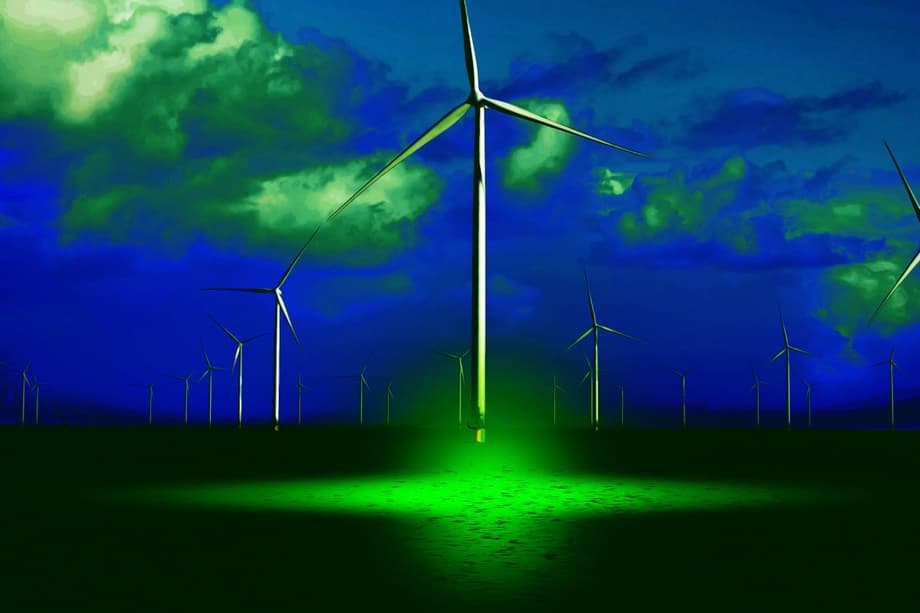A new model for computing at sea
China has switched on the first phase of a data center placed on the seafloor near Shanghai, a site designed to pair offshore wind power with ocean cooling. Built by HiCloud, the project starts with a 2.3 megawatt demonstration that is planned to scale to 24 megawatts. It sits off the coast of the Lingang Special Area, with most of its electricity supplied by nearby offshore turbines and heat removed by circulating seawater around sealed server cabins. The investment for the build is about 1.6 billion yuan (roughly 226 million dollars), and operators are targeting a power usage effectiveness of 1.15 or lower, which would put the site among the most efficient facilities of its kind.
The approach reverses a long standing limitation in data center design. Traditional campuses use chillers and cooling towers, and those systems can consume 40 to 50 percent of a site’s power budget. By using the stable, cool environment of the seabed, the underwater installation aims to drive cooling energy below 10 percent of total use. Designers estimate total power demand will drop by about 22.8 percent compared with an equivalent land facility. The site also cuts land use by more than 90 percent and needs no freshwater for cooling, two constraints that are acute in dense coastal cities like Shanghai.
The project builds on several years of trials in China. Off Hainan Island, HiCloud has already deployed a commercial undersea installation about 35 meters (114 feet) below the surface, using pressure resistant pods that carry 400 to 500 servers each. The pods are linked together and connected to the mainland by a subsea cable. Those modules are seen as a stepping stone toward a larger cluster, part of the national Eastern Data, Western Computing program to expand capacity and balance where computing happens across the country.
Where and how the system works
The Shanghai site lies off the coast near the Lingang Special Area of the China (Shanghai) Pilot Free Trade Zone. Fiber links carry data to and from the submerged modules, which are anchored to the seabed to limit motion in storms. Power cables connect the site to an offshore wind farm that supplies more than 95 percent of the electricity. Early operation will focus on a compact array that can hold 198 server racks, with room to grow as more pods are added in the next phase.
Efficiency metrics explained
Data center operators watch a ratio called power usage effectiveness, or PUE. It divides the total power a site draws by the power delivered to the computing equipment. A theoretical PUE of 1.0 would mean every watt goes to servers and none to cooling or overhead. China’s national policy sets a requirement that new data centers should be below 1.25 by the end of 2025. The underwater site is designed not to exceed 1.15. That is in line with the best land facilities that use advanced cooling and energy management, and it is well below many older sites that still operate above 1.4.
Cooling and energy use
Seawater has high heat capacity and stable temperatures, which makes it an efficient sink for removing waste heat. In the Lingang design, seawater flows across heat exchangers attached to the server cabins, absorbing heat that is then dispersed into the surrounding water column. This method avoids the large fans, chillers, and evaporative cooling used on land. Because the pods are sealed from air and kept at stable temperatures, electronics also avoid dust, humidity swings, and vibration from people and equipment. These conditions can extend hardware life and reduce failure rates, outcomes that earlier underwater trials by other firms reported.
Why China is doing this now
Computing demand driven by artificial intelligence, video, e commerce, and connected industry is rising fast. Training and running modern AI models requires dense clusters of graphics and tensor processors that draw large amounts of electricity and produce intense heat. At the same time, municipalities face tighter limits on land, water, and emissions. Locating a data center offshore helps address each constraint. The East China Sea has rich wind resources, with more than 3,000 hours of annual utilization cited by developers, and the seabed provides natural thermal stability for cooling.
Shanghai’s plan calls for a leap in smart computing capacity and industry output by the middle of this decade, with a target of 200 exaFLOPS of compute and an intelligent cloud industry worth hundreds of billions of yuan by 2027. Building capacity near where data is generated, while using nearby renewable energy, reduces transmission losses and latency for coastal users. It also complements the national strategy that routes some workloads to large campuses in the west of the country. The underwater site reduces land footprint and freshwater use to near zero, which lowers local environmental strain compared with a large new land campus.
Developers have also set their sights on scale. HiCloud and partners including Shenergy Group, the Shanghai branch of China Telecom, INESA, and CCCC Third Harbor Engineering signed an agreement to pursue a much larger cluster, with an ambition of 500 megawatts of underwater capacity powered by offshore wind. That goal would move the concept from demonstration into a mainstream option for building out national computing.
Environmental and marine impacts
Any project that releases heat into the ocean needs to manage its thermal plume. Warmer water carries less dissolved oxygen and can stress marine life, especially during summer and marine heat waves. Developers say testing during earlier pilot deployments showed less than a one degree Celsius rise in nearby waters, but continuous monitoring will be essential as capacity grows. Diffuser designs, smart flow control that ramps down during sensitive periods, and careful siting away from vulnerable habitats are all tools that can help keep impacts low.
Beyond heat, engineers must also consider noise, electromagnetic fields around power and data cables, and the risk that construction or maintenance disturbs benthic ecosystems. Antifouling strategies for the pod exteriors should avoid toxic coatings, and corrosion control must be designed not to contaminate surrounding water. Regulators will likely require detailed environmental impact assessments, baseline surveys, and ongoing public reporting on water temperature, noise, and marine life near the site. If executed with rigorous oversight, the energy and water savings from ocean cooling can be balanced with protection of the local environment.
Security, resilience and maintenance
Moving servers to the seabed adds a new threat model. Cables and pods can face hazards from anchors, trawling gear, storms, or deliberate tampering. Operators can mitigate some risks with exclusion zones, seabed trenching or armoring for cables, sonar surveillance, and alerts that detect unusual activity around the site. Researchers have also warned that sound based interference could, in rare circumstances, affect sensitive equipment, which makes acoustic monitoring and robust shielding important in design and operations.
The ocean environment can also improve reliability. The pods are sealed, free of dust, and kept at steady temperature and humidity. That reduces corrosion and mechanical stress, and past trials in other countries recorded far lower hardware failure rates than typical land centers. Stable conditions help power distribution equipment, storage, and interconnects operate within tight tolerances, which is critical for AI training clusters that need high performance networking.
Maintenance changes shape. Engineers cannot walk into an underwater hall to swap a component. The system must be modular. If a rack or power unit fails, operators replace an entire pod or slide out a sealed module brought to the surface during a planned service window. Marine growth, corrosion, and seals will dictate inspection schedules. Designing for quick retrieval and re deployment, with clear interfaces and standardized parts, will be the difference between an elegant concept and a practical, resilient service.
Economics and scale
Capital costs are high. A multi hundred million dollar build covers subsea cabins, marine construction, specialized power and cooling gear, and integration with an offshore wind farm. Yet operating cost can be attractive if PUE remains near 1.15 and if the site sources power directly from local turbines. The largest expense in a modern data center is electricity. A lower PUE means more of that electricity goes to computing rather than overhead. In cities where land and water are scarce, the avoided cost of real estate, cooling towers, and water rights also matters.
Offshore work brings its own premiums. Weather delays add cost and uncertainty. Insurance, vessels, and specialized crews push up prices. Some of those costs fall with experience and standardization. China’s offshore wind supply chain is mature, which can help on price and schedule. If the Lingang site proves reliable and easy to service, the economics of building additional capacity improve. Partnerships with large network operators and energy companies also help fill racks with paying customers and align the project with grid planning.
How it compares with earlier attempts
Underwater data centers are not a new idea. A decade ago, Microsoft’s Project Natick tested a sealed steel capsule off the Pacific coast and later deployed a 12 meter unit with 864 servers off the Orkney Islands. The company reported very low hardware failure rates, likely helped by the stable environment and a nitrogen filled interior. It ended the research program in 2024 and said it would not commercialize the concept. The Shanghai effort goes in a different direction. It is tied to an offshore wind farm, targets a tighter PUE, and is part of a broader city and national plan to expand computing capacity.
Other companies and countries are studying ocean cooled or underwater designs. Startups have proposed small subsea modules close to shore, and research groups in South Korea, Japan, and Singapore have explored marine cooling and siting. On land, operators continue to push high efficiency with warm water liquid cooling, heat reuse into district energy networks, and new chip architectures that reduce power draw. The ocean based model will need to demonstrate that its benefits exceed those of the best land alternatives when all costs and risks are counted.
What to watch next
The demonstration phase near Shanghai will provide hard data on PUE, reliability, and service procedures at sea. Independent audits of the energy balance and environmental performance will be important for public confidence. Monitoring water temperature changes around outfalls, tracking noise levels, and reporting marine life observations can show whether large scale deployments are compatible with local ecosystems. Regulators can make those disclosures part of permits and renewals.
Two milestones will shape the near term narrative. The first is the ramp from 2.3 megawatts to the planned 24 megawatts, which will test whether installation and maintenance scale smoothly. The second is progress toward the 500 megawatt ambition announced by the developer and its partners. That would require a larger footprint, more turbines, and stronger grid connections. It will also require standard pod designs, clear service playbooks, and supply chains that can deliver modules quickly. If the model holds in Shanghai, similar coastal regions with strong offshore wind and tight land constraints may move to replicate it.
Key Points
- HiCloud has activated a seafloor data center off Shanghai, starting with a 2.3 megawatt demonstration that is planned to reach 24 megawatts.
- More than 95 percent of the site’s electricity comes from offshore wind, and seawater provides the cooling.
- Operators target a PUE of 1.15 or lower, beating China’s national guideline of 1.25 for new data centers by the end of 2025.
- Designers estimate about 22.8 percent lower total power use versus a comparable land site, with cooling energy cut to below 10 percent of total consumption.
- The project cost is about 226 million dollars, and the initial array can host 198 server racks inside pressure resistant pods.
- Earlier Chinese trials in Hainan placed pods about 35 meters deep, each carrying 400 to 500 servers, linked to shore by subsea cable.
- Benefits include a land footprint reduced by more than 90 percent and no freshwater use for cooling.
- HiCloud and partners have announced an ambition to build a 500 megawatt underwater cluster powered by offshore wind.
- Environmental oversight will focus on heat discharge, noise, and cable impacts on marine life, especially during warm periods.
- Past underwater trials abroad reported low hardware failure rates, but large scale operations at sea still face maintenance, security, and cost challenges.




